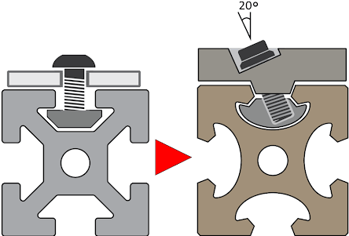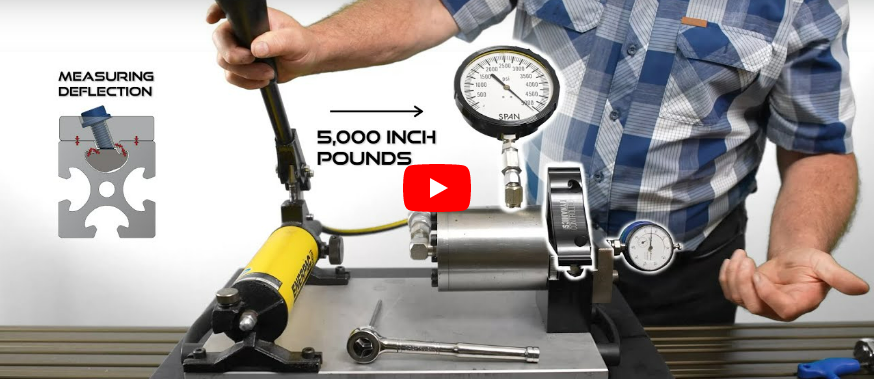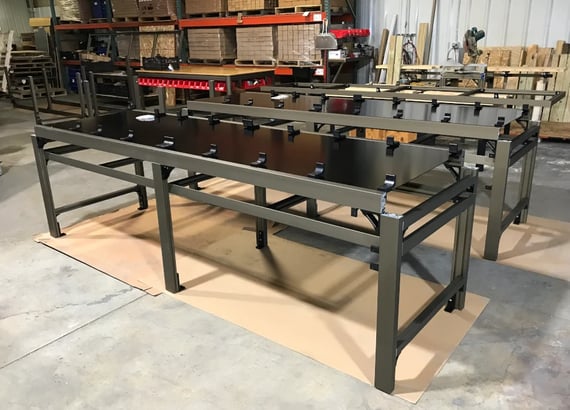Aluminum Structural Framing Systems: T-Slot Pros, Cons, Alternatives

Can you truly improve what’s already been the accepted and established product and process for nearly 50 years?
Depending on your application, absolutely.
For decades, modular aluminum systems have been synonymous with T-slot extruded profiles. Unknown to many, a similar-but-different system has been in use across a growing number of industries. Called AngleLock, its components are built to eliminate frustrations related to lack of precision, reliability, and joint strength that T-slot users know too well.
Below we’ll explain the basic differences between traditional T-slot aluminum and its “best-kept secret” competitor. Then we’ll review each metal framing system in six key project criteria, and pick a winner.
Aluminum Structural Framing Systems: Wait, There’s a Difference?
Since you may not have known other structural framing solutions existed, let’s separate what’s “alternative” vs. “traditional.” First, recall the characteristics of the tried-and-mostly-true T-slot profile:
Traditional T-Slots

T-slotted components are a standard of framing design.
As you probably know, a T-slot’s fasteners are perpendicular to the profile. What you may not be aware of is that there’s large clearance between the bolt and the hole of the bracket. Because of this clearance, T-slot systems work as a pivot, relying on friction to maintain alignment.
T-slots are:
- Created via extrusion processes
- A modular design used with a variety of components
- By far the more widely known solution
The Emerging T-Slot Alternative
Because of concerns with T-slots’ longstanding limitations, more manufacturers are considering a new (but not as new as you think) contender in aluminum extruded components.
Here are its basics:
- Nearly identical manufacturing process
- Often lumped together with T-slots
- Emerging, growing market
- A 100% unique approach to structural support
That last point is the big one. What makes this not-quite-a-T-slot – simply called AngleLock because there’s no generic version of it – so distinct?

(AngleLock is similar in appearance but very different in performance)
It starts with aluminum extrusion technology that connects profiles via self-aligning brackets with angled bolts.
This change to the formula results in five planes of anchoring, which in turn allow for a non-moveable structure. It eliminates all pivot points by creating a mechanical lock.
Compare this to a T-slot, which makes contact with the assembly in a single direction. It relies on friction to secure the joint.
Where does your application come in? When used correctly, this self-aligning tech can create across-the-board improvement for many kinds of projects.
Review: T-Slot’s 1975 Aluminum Structural Framing vs. 2023 Technology
To get an idea of where AngleLock framing system technology stands vs. traditional solutions, consider what your project might value most:
- Strength
- Precision
- Versatility
- Service life
- Cost
- Lead time
1. Strength
Any aluminum modular structural project enters the factory floor with an M.O. of marrying strength with lightweight design. However, the tradeoff only works to a certain point.
T-Slot Strength
The very function of a T-slot in a framing assembly is problematic for achieving reliable strength.
An example is a custom extruded bracket cut with a saw. The manufacturer then machines it on a standard, three-axis CNC machine center to drill holes with generous clearance perpendicular to bracket/profile mating surface.
Because the joint relies on the clamp load of the bolts to create friction, it can easily shift any direction perpendicular to the bolt axis. As a result, the assembly only draws a fraction of the strength potential of the profile.
It turns out strength is about much more than just the material itself …
AngleLock Strength
This T-slot alternative’s bracket starts with a similar, but more thoroughly engineered custom extrusion.
The maker then machines the bracket on a five-axis (or more) CNC center to drill the angled holes and mill the precision locating features. Then the manufacturer adds corner radii and edge breaks so there are no stress risers on the component.
Working with a standard 40 mm (1.57 in.) profile, you won’t see much difference between the two structural systems in a simple, static application. The results start to diverge as your application becomes more complex or dynamic, as the AngleLock system’s mechanical lock creates a joint as stiff as a weldment.
The joint is much stronger, able to use the full strength potential of the profile, unlike a T-slot system.
Winner: AngleLock, in most applications
2. Precision
Keep this in mind as you continue: Connection is the most important part of a structural assembly.
T-slot and AngleLock components are so similar on the surface that they even look alike to the untrained eye. Look under the hood and at the connections, though, and you’ll see a truckload of difference.
T-Slot Precision
T-slot use creates a pivot in the assembly. Brackets are able to move around because of the clearance in the bolt hole. Tightening the component also forces the assembly apart from its once-precise alignment as it distorts the T-slot.
In a static environment – one without movement or vibration – a traditional framing extrusion works just fine. However, in a more demanding environment, the system may experience:
- Misalignment
- Loosening
- Reduced ability to handle stress
AngleLock Precision
Remember the emphasis on connection?
AngleLock supports structural assemblies by borrowing a design concept popular in:
- Aerospace
- Architecture
- Trucking
Think of a Boeing 747 – each plane has 80,000 solid rivets. When the builders hammer them in, they expand and fill the space, and there’s no clearance. There’s a tightly bonded, solid connection.

(Click the screenshot for a video blog showing the function of an AngleLock connection.)
Why? Because the system uses angled bolts that pull the bracket’s locating shoulder against the slot of the profile (which you’ll see in the video above). If a load forces the bracket to move at all, the angled bolts act as springs to pull it right back against the profile’s locating surface.
Compare the list of T-slot tolerance issues above with what you see in AngleLock parts:
- Precise mechanical bond
- Tightening actually further bonds the component
- Even vibrations tighten the connection!
In low-intensity applications, these two framing solutions provide similar results. But when you need heavy-duty structural aluminum framing for a dynamic (moving) assembly, the difference is obvious.
Winner: Draw for static uses; AngleLock for dynamic uses
3. Versatility
Modular aluminum structural framing systems should be flexible across situations and uses. After all, they’re “modular” for a reason, right?
T-Slot Versatility
Let’s start with the good. T-slot extrusions have been around since 1975, so there’s no shortage of battle-tested solutions with them. Because there are many highly similar profiles, check with the supplier’s engineers to ensure their solution fits your project to a T (no pun intended).
Along with a much wider profile variety, there’s also more cross- and backward-compatibility. For example, you can easily mix and match brackets from the popular 80/20 and Bosch framing systems.
Now for the bad: The already-outlined issues with traditional aluminum T-slots limits their range of applications. Most successful uses are in static situations where you don’t have to worry about the framing system falling apart 3 years prematurely.
AngleLock Versatility
Since these products are limited to a single manufacturer and have a shorter history, there are fewer profiles from which to choose. And while they’re compatible with T-slot modular framing system components, mixing and matching isn’t quite as simple.
There is, however, a unique way AngleLock framing systems score high in flexibility. Like welded framing components (another solution commonly compared to AngleLock), the system acts as a single piece. However – unlike welded framing – you can take apart AngleLock assemblies.
 (Work-in-progress conveyor assembly)
(Work-in-progress conveyor assembly)
Then, of course, there’s the situational flexibility this newer extrusion technology provides. Its uses in heavy-duty industries include, but aren’t limited to:
- Aerospace – Fastenings for aircraft fixtures and engine stands
- Defense – Service platforms & stands for aircraft maintenance
- Automation – Conveyors & machine bases
- Material handling – Fastening systems for heavy-duty pallets
- Robotics – Custom-engineered cabinets & enclosures
- Other manufacturing – Factory workstations, vibratory bowls, platforms, & carts
Winner: Draw
4. Service Life – Maintenance & Replacement
Hopefully you look at a product’s useful life in two ways: maintenance (short-term) and replacement (long-term). The first helps delay the second, but ideally your aluminum extrusion framing system offers some of both.
T-Slot Lifetime
Do you have a maintenance guy coming in once a month to tighten 200 bolts on the framing of a robot enclosure?
It’s a ridiculous notion, but one that’s all too real with T-slot extrusions.
Because T-slots rely on friction to hold a system together, they’re prone to disruption from outside forces. Continued movement loosens the framing system over time, eventually causing it to fall apart.
If you’ve watched light curtains slowly sag until they’re unusable, you may be missing opportunities to reduce maintenance and increase product lifetime.
You may also be overlooking a safety concern.
A T-slotted framing assembly typically needs more bracing compared to alternative solutions. That bracing makes it harder to access the areas of the machine that require maintenance.
AngleLock Service Life
While you can’t predict a pivot that relies on friction, you can predict a mechanically bonded framing system.
Because it avoids unnecessary wear and loosening, this type of aluminum modular framing can dramatically extend the structure’s service life. This is particularly true for high-wear applications involving movement and vibration. And because the self-aligning framing components tighten over time, they all but eliminate the need for maintenance.
If for some reason you do need to check on the assembly, the reduced bracing makes access easier and safer.
As a bonus, AngleLock allows for easier use of Finite Element Analysis due to the predictable, bonded nature of its joints. Especially with critical-use components, it’s valuable to ensure your aluminum extrusion framing can handle the pressure of real-world use.
Winner: AngleLock by a mile
5. Cost
There’s no one-step explanation or comparison for the cost of aluminum extrusion framing systems. Plenty of factors contribute to production, assembly, and upkeep costs.
T-Slot Cost
If your extrusion framing’s up-front cost is your only concern, T-slot will often win the debate. On the occasions they end up more expensive, it’s because the application required more brackets to achieve a similar level of performance.
Another cost driver for T-slot? Time (which we’ll discuss more in a bit). The structure takes more time to:
-
Align
-
Assemble
-
Realign
Post-construction costs are another, much scarier story. Since T-slot aluminum framing requires consistent maintenance, higher risk of production delays, and more frequent replacement, the long-term costs often outweigh initial construction costs.
AngleLock Cost
This structural framing system is the go-to for lowering life-cycle costs.
The self-aligning marriage of brackets, bolts, and nuts keeps your framing secure for years to come. That’s why the up-front cost is sometimes higher – because you won’t need another modular framing system for a long, long time. You’re also paying more up-front for the instant improvements in quality:
-
Highly engineered components
-
Tighter tolerances
-
Advanced manufacturing techniques
Occasionally, there are also cases where AngleLock is more cost-effective up-front because it could accomplish certain specs with fewer components. AngleLock structures can also be assembled in 50% of the time, which can deliver additional project savings.
Winner: T-slot for quick-and-dirty jobs; AngleLock for long-term success and assembly-intensive jobs.
6. Lead Time
Speaking of quick and dirty … Is your company in constant “fire drill” mode? Or is quality atop your list when vetting suppliers?
T-Slot Lead Time
No matter where you are in the United States, T-slot stock is readily available. And since there’s a massive library of profile types, it’s nearly a guarantee you can get exactly what you want ASAP.
Assembly of those parts may require a little more lead time. Not all T-slots use the same sizes of brackets and nuts. Hopefully the supplier’s catalog tells you which brackets and nuts you’ll need so you don’t waste time tracking this down or redoing mistakes.
AngleLock Lead Time
At first glance, the manufacturing process here is nearly the same. Even so, the bigger picture shows an opportunity to speed up an underappreciated factor in lead times – assembly of the modular framing.
On an AngleLock extrusion framing system, nearly all bolts are the same size on a given application. Integration looks like this:
- You buy it …
- … Open the box …
- … It’s already self-aligning …
- … You’re done.
That’s it. The unpackaging-to-assembly process is about 2x faster than with T-slots. What’s more, AngleLock framing components are pre-assembled with all necessary hardware, whereas some T-slot suppliers sell and send brackets, nuts, and bolts separately.
The obvious downside is that there aren’t multiple suppliers or distributors for these parts. And again, the library of profile types is comparatively small (but growing). If you need an overwhelming volume of components, or you have several custom needs, lead time may exceed what you’re used to.
One redeeming aspect of including AngleLock in your supply chain is that you can often skip the middleman. The ability to design and manufacture custom brackets means you can receive an aluminum framing system without involving a third-party integrator.
Winner: T-slots (with an asterisk for complex assemblies and highly custom needs)
The Verdict: Aluminum Structural Framing Systems
Aluminum framing systems support your product, your manufacturing process, and your success. Why wouldn’t you explore all options?
You may be able to stick with your current T-slot solution if your:
- Application is low-intensity
- Up-front budget is strapped
- Application uses a wide variety of immediately available components
Consider a switch to another aluminum framing system if you’re:
- Held to tight tolerance specs
- Seeking reliable strength
- Losing productivity to downtime
- Serious about product quality and innovative solutions
Curious about where your project fits into the debate? Learn more about optimizing your structural aluminum framing system here:


Leave a Comment